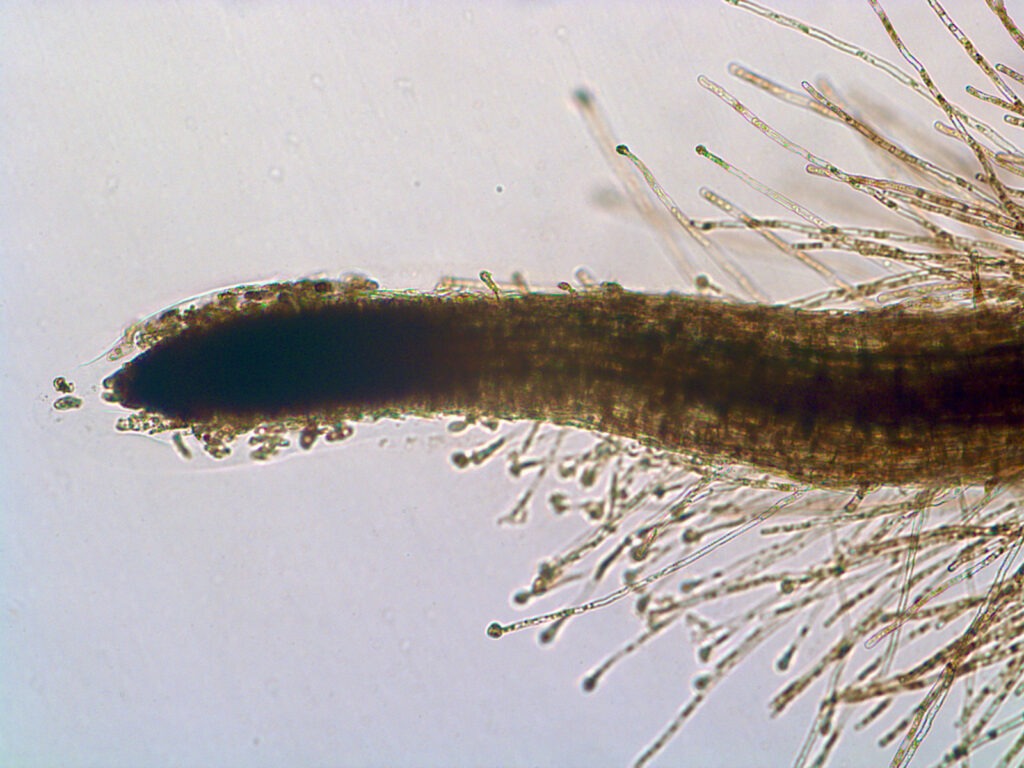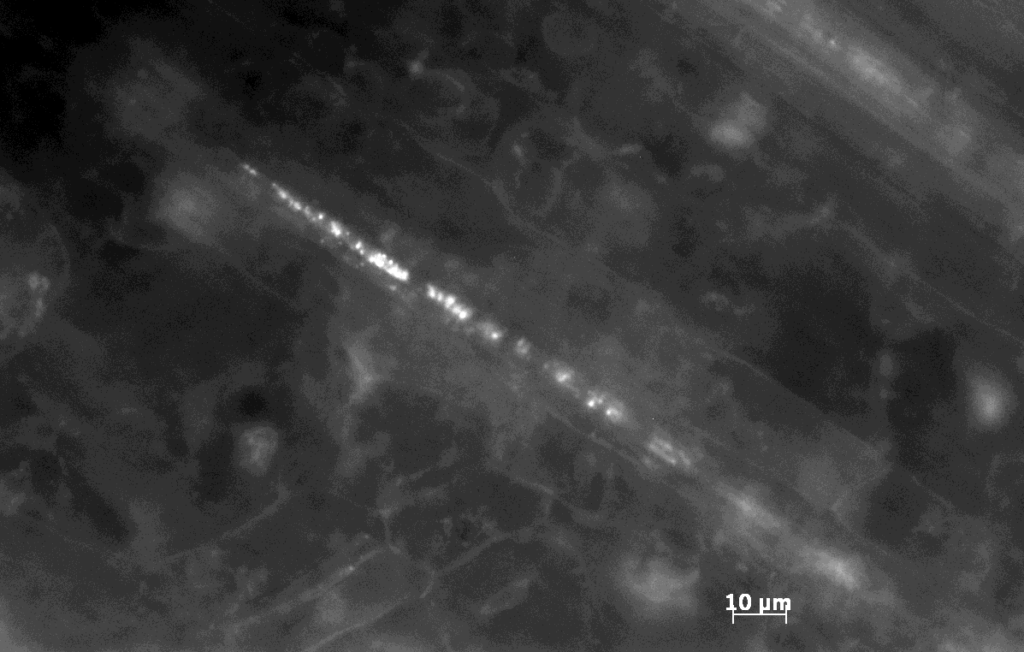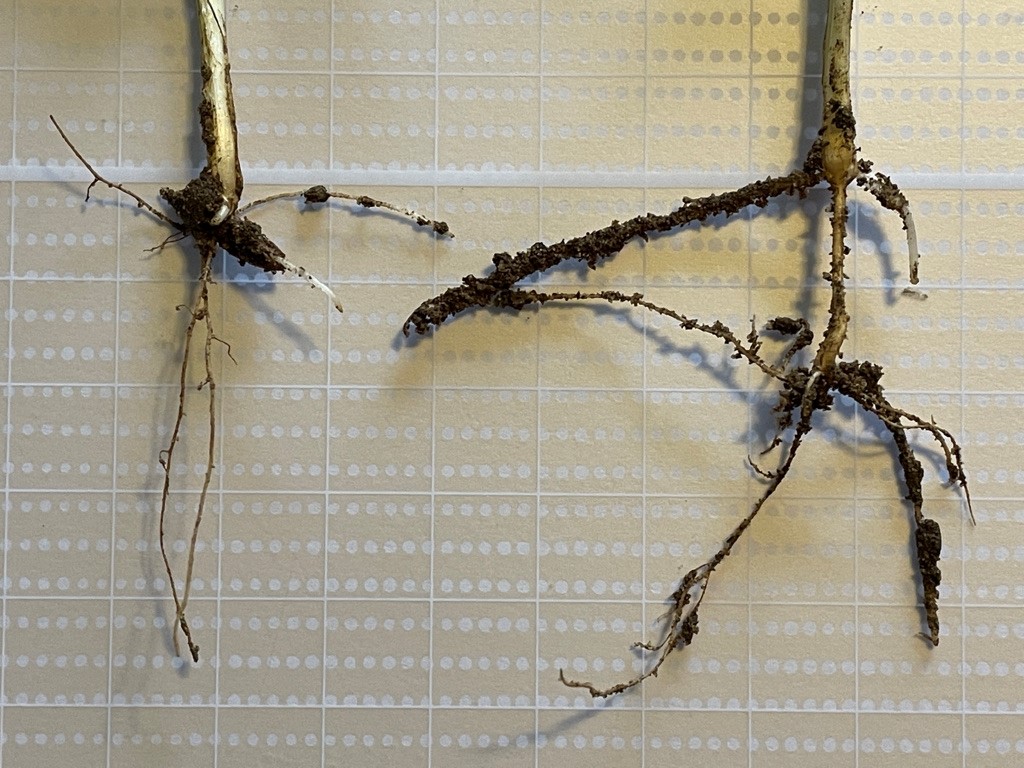Plants depend on microbes and microbes depend on plants. Direct Driller explores this special relationship and asks whether novel biological amendments can supplement natural processes.
By Lucy de la Pasture
‘Very few researchers understand the degree plants are dependent on microbes for their development’, that’s the view of Professor James F White who specialises in symbiosis research at Rutgers University in New Jersey, USA.
To understand why this is, James’ team at Rutgers has gone right back in time to look at the plants that first evolved to live on land. His group has found endophytes in green algae and very primitive plants, the bryophytes (which includes liverworts and mosses), a discovery that indicates microbial communities have been associated with plants from the very beginning.
Understanding the evolutionary process is important because plants can’t develop properly and grow in the absence of microbes, explains James. A landmark evolutionary event occurred around 500 million years ago when in the evolutionary game of chance, a union was made between a eukaryotic organism (having a nucleus) and a photosynthesising cyanobacterium. It marked the origin of plant life which eventually evolved to leave the water and populate the land.
But it was also the very beginning of a special relationship between plants and microbes. When the first plants populated the land, plants needed microbes to supply nutrients to them in the thin ‘soil’, and microbes benefitted because the plant supplied them with sugars.

“It really paints a picture that when plants first came onto dry land, they had endophytic microbes within them. We now know that plants use endophytes to adapt to whatever environment they find themselves in, and they are critical not only to their growth and development but for their health and disease protection,” he says.
Endophytes aren’t single microbes, they’re communities of soil organisms that plants recruit to help them adapt to their environment. They can switch endophytes depending on their needs at any time, explains James.
The discovery of how plants utilise these endophytes is relatively new. The interaction was first observed by a group of Australian microbiologists in 2010 and dubbed rhizophagy, but it was the team at Rutger’s university that delved further into the detail and first described the rhizophagy cycle in which plants seem to ‘farm’ microbes for their own benefit.

The process gets underway by plants secreting exudates at their root tips which serve as signalling molecules to attract beneficial communities of microbes, he explains.
“At the root tip meristem, these microbes are somehow internalised by the plant – we don’t yet know the exact mechanism. Once inside the root tissues, the plant produces superoxide which oxidises the bacteria, stripping off the bacterial cell walls to leave protoplasts. It is from these that the plant extracts nutrients.”
What happens next emphasises how plants are dependent on microbes for more than just food, they also need them for root hair development. They do this by secreting substances such as ethylene, nitric oxide and other hormones that trigger root hair elongation.
Some bacteria die during the process but many that survive are ejected back into the soil from the tips of elongating root hairs, where root exudates encourage their cell walls to reform. And the cycle begins again as the microbes migrate away from the root to acquire the additional nutrients they need to grow and then return to the exudates at the root tip,” explains James.
Rhizophagy is a system common to all plants with root hairs. “Without the rhizophagy cycle, roots appear ‘naked’, without root hairs, and you don’t see this much in nature, perhaps only in very acid soils.”
Because the symbiotic relationship between plants and endophytes is especially important in their early development stages, a seed producing plant will place some of its endophytes onto and into its seeds, adds James.
“Seed producing plants systematically use these bacteria and move them onto their seeds so that endophytes are in situ when the seed germinates, aiding root hair development and elongation as well as supply of nutrients to the seedling. Later, some plants will form mycorrhizal associations which will take over the process of acquiring nutrients.”
It’s a process that’s understood by many regenerative farmers that home-save seed because they’re aware it already contains the endophytes adapted to the environment it will be planted into.

With the focus in farming only recently turning to soil biology and recognising its important function, modern farming practices have left many soils with depleted microbial communities.
“We didn’t understand the importance of microbial communities in the soil and over the years, we’ve used so much chemical fertilisers that we’ve destroyed many of them. But now we understand the soil microbiome is important.”
Boosting microbial communities
That begs the question, can we supplement the soil biology by providing the plant or seed with endophytes?
“I’m a firm believer in biostimulant microbes because they work. Mostly they’re available as soil microbes but sometimes they come from plants. When you apply them to the seed, they’ll replace some of the microbes that were lost so that when the seed germinates, the plant will internalise these microbes and kick-start the rhizophagy cycle.”
Biologicals can also act as a supplement in soils where microbial communities are depleted but it may not be a long-term effect. “In the longer term, once the plant’s roots start growing, other microbes from the soil or microbes that happen to still be in the plant seed will come in and take over. And in many case the microbes you put on will become less important,” says James.

“However, there are some biostimulant microbes that have been isolated from plants and the intention with those is that they establish a more permanent relationship with the plant. The proviso is that the consortium selected is adapted to the crop plant and the plant needs that community in its environment,” he adds.
Not all endophytes get stuck in the rhizophagy loop, instead the plant moves some of the bacteria from the root and spreads them throughout its tissues. “Many plants will put these bacteria into their leaf hairs (trichomes) where they feed them plant sugars in exchange for the nitrogen these endophytes will fix from atmospheric nitrogen,” explains James.
Increasing nitrogen and phosphorous bioavailability
Landrace corn with nitrogen fixing ability has been discovered in Mexico. It possesses larger and longer filamentous trichomes and is highly nitrogen efficient, a trait that could potentially be brought into commercial corn varieties.
“We can see the nitrogen around the bacteria in these trichomes and we think this nitrogen fixation is happening in trichomes all over the planet.”
It was the ability of popular and willow to not just survive but to thrive on the banks of the Snoqualmie River in western Washington State that led University of Washington’s Prof Sharon Doty to investigate how these plants are able to grow so well in such adverse conditions.
Somehow, the native plants were getting more than adequate nutrition despite the very low nutrient content of the Snoqualmie River, which originates from snow melt and contains less than 0.5 mg/l total nitrogen, and without root nodules to account for N-fixation. The rocks and sand deposited by the river also supply little to no nutrients.
The team at the Doty lab isolated a wide range of symbiotic microbes from the plants’ branches and confirmed N-fixation was occurring in above-ground plant tissues by tracking labelled nitrogen. The results were also supported by the presence of microbial nitrogenase genes in the wild poplar microbiome.
“Over the past two decades of characterising these strains, we’ve determined that some of these microbes make nitrogen and phosphorous bioavailable, increase photosynthesis and water use efficiency, as well as promote plant growth, yields, and health under drought and nutrient stresses,” she explains.

Using endophytes in the field
A consortium of these bacterial endophytes, isolated from the strains from the Snoqualmie wild poplar, was developed by US-based Intrynsyx Bio as a seed treatment optimised for integration into diverse cropping systems. These endophytes are now available as TIROS Max, which has now superseded Unium Bioscience’s flagship product TIROS.
“The endophytes in TIROS Max are generalist and using electrofluorescence, we’ve seen them move via the vascular system of the plant,” explains Unium’s director John Haywood.
“These plant-microbe associations are known to be beneficial for germination and seedling establishment. Seed endophytic bacteria are found naturally in these early plant growth stages, but TIROS provides a combination of highly functional strains that wouldn’t normally be present to form additional associations with the host plant.”
John describes Tiros as a ‘back-up generator’ that’s running all the time the plant is growing. “When nitrogen and other nutrients are limiting, the endophytic bacteria within the plant tissues provides a solution – helping the plant keep going and then recover once conditions become more favourable.”
As for the permanence of the association between the novel endophytes and crop plants, the data suggests a lasting effect.
“Trials have shown that the endophytes in TIROS Max significantly increase the biomass (shoot and root) over and above untreated and other seed treatments, and it is long-lasting. In winter barley trials, the difference in biomass (compared with untreated) became evident 60 days after treatment and continued to increase at a far greater rate in the following months.
“The larger leaf area has also been found to contain more chlorophyll, improving the photosynthetic capability of plants and ultimately increasing yield. Over 30 trials the average yield response was 0.58t/ha (range -0.19t/ha to 1.84t/ha) and we calculate Tiros is likely to give a 90% chance of return on investment from the data.”
As explained by James, endophytes also improve the plant’s nutrient use efficiency (NUE). In crops where Unium endophytes have been applied, the leaves have been tested to show a higher accumulation of nitrogen. “This is the case for other nutrients, including phosphate and potash, which may be particularly useful where phosphate is locked up in the soil,” explains John.
“Our trials with the TIROS Max endophytes indicate a contribution of around 30Kg N/ha to nitrogen supply. It’s able to facilitates more from less by maintaining yield where N inputs are reduced and supporting yield increases where standard N rates are applied.”
A new generation of biological seed treatment
Building on the reliable performance of TIROS, Unium has developed a unique, advanced formulation of endophytes which supports and enhances rhizophagy during early development and enables crops to fix atmospheric nitrogen (N).
The new formulation provides a prebiotic, also known as an extender, in powder form rather than a liquid. This change removes a mixing phase when preparing the seed treatment and provides more flexibility in the size of batches which can be treated, with smaller quantities of one and five tonnes now able to be treated as well as the standard 10-tonne pack.

The extender is a crucial part of the TIROS Max seed treatment and reduces the variability in performance seen historically when live biological products are applied to seeds. The new formulation delivers 13% more Colony Forming Units (CFUs) per seed than TIROS and is effective at preserving the endophytes during application, as well as supporting and promoting early population growth during germination and establishment.
“The new formulation for TIROS Max now sets the bar even higher. It marks a real advancement in seed treatment technology by supporting the biology to a greater extent, demonstrated by the higher CFUs achieved per seed,” comments John.
Want to know more about endophytes?
To celebrate the launch of TIROS Max, Unium is hosting an educational evening on endophytes in collaboration with BOFIN. Two of the leading researchers in this field are joining us in a special webinar on July 2nd at 6pm.
Prof James White of Rutgers University in New Jersey will outline his research into rhizophagy and how endophytes affect root development and Prof Sharon Doty of the University of Washington will outline the discovery of endophytes that can fix atmospheric nitrogen in non-nodulating plants and sequester phosphate.
The feature event of this educational evening on endophytes will be a ‘fireside chat’ where both researchers will be joined by agroecology consultant Ben Taylor-Davies in an interactive, no-holds barred discussion. With questions from the audience, there’s the opportunity to find out anything you want to know about endophytes, including how farming practices affect them and how effective it is to supplement naturally occurring endophytes with biological amendments.
For further information and to register, click here



